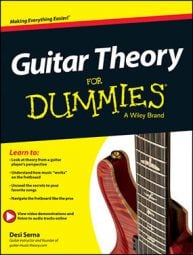Learning songs on the guitar is the absolute best way to develop as a musician. Every song you learn teaches you something new about using chords, playing progressions, and applying scales (not to mention licks, phrasing, fingering, and overall technique). For each new song you study, identify its components and analyze how it’s put together. For example, answer the following ten questions about every song you work on:
What’s the key of the song?
What’s the parent major scale of the music?
On which major scale degree is the tonic chord based?
How would you number the chord progression?
From which CAGED forms are the chord shapes drawn?
Does the song change keys?
Which type of scale patterns does the song use?
How is the music similar to other songs you play?
What are some other ways that you can play the song?
How can you borrow ideas from the song to play over other songs or compose your own music?
Learning a song today is as easy as searching its title in a search engine. After all, just about any song you can imagine is available online for download. Plus, you can stream a lot of music for free online, and you can find official, complete, accurate tabs to most popular songs in songbooks or individual scores. You can even download songs off the Internet to play anytime you want.
How to practice by playing along with songs on the guitar
Aside from learning parts from songs, you can also play along with them as you practice. Keeping up with the pace of a recording helps you develop timing and endurance. Plus, it gives you an opportunity to hear your part harmonically mixed with the rest of the music.
Recorded music makes for a great play-along track even when you’re not playing parts from that specific song. For example, you can practice G major scale patterns simply by playing them over a piece of music based in the same scale. Hearing how the scale mixes harmonically with the rest of the music really brings it to life.
How to practice by recording yourself on the guitar
When you play guitar, your mind can become so focused on the physical tasks of fretting and picking that you fail to properly sense other important aspects of music like pitch, timing, feel, and tone. The way you think you sound while playing is often quite different from how you really sound. The best way to critique your playing is to listen to a recording of yourself.
You don’t need a lot of fancy technology to record yourself. Most computers, laptops, tablets, smartphones, and other portable devices have features, programs, and apps that you can use to record yourself. For example, you can just set your Phone on your lap or in front of your amp as you practice and play, using the built-in voice memo.
Basics of looping on the guitar
A loop is a repeated section of sound material. You can make loops with a wide range of music technologies, like recording programs, drum machines, and guitar effects pedals.
As a guitarist, you can easily add a loop pedal into your signal change so that you can record and play back your playing at the stomp of a foot. The most popular unit for this use is the Boss Loop Station, which is available in different models. However, other manufacturers produce products that do the same thing.
When using a loop pedal, you plug your instrument into the pedal and then connect the pedal to your amp. When you stomp on the pedal, the device starts recording you. When you stomp on it again, it plays back what it just recorded. After it reaches the end of the recorded section, it immediately starts again from the beginning.
How to practice with others on the guitar
Playing with others is good for both practice and play. Other musicians can give you feedback, share ideas, provide accompaniment, and trade licks. Learning and practicing aside, it’s fun just to hang out with others doing something you love. After all, we humans are relational beings; we’re made to harmonize with one another.
When playing with others, you can have one person play rhythm while another plays melody, sings, or improvises. You can then trade parts.
How to take advantage of music theory resources
One of the best ways to develop your understanding of music and guitar playing is to keep on studying! Countless books, DVDs, and websites offer guitar instruction and music theory lessons. You don’t need to master everything that’s out there, but it’s helpful to always have something that you’re slowly working your way through. That way, you’re always making progress and developing new skills and techniques.
Learn how to read music. Understanding music notation influences how you play the guitar even when you don’t have sheet music in front of you. Plus, you’ll be better able to follow charts and lead sheets when the need arises. You don’t have to learn to read like a concert violinist; just learn the basics.
How to set reasonable, realistic goals
If you’re serious about progressing as a guitarist, you need to set some goals. You don’t have to set major goals— just something simple that you can work toward. A good goal is to learn a song or a part of a song. Maybe your goal is to play at an open mic night or at church or to make a YouTube video to share with friends.
Whatever the case may be, just set small, achievable goals that give you a target to set your sights on. Then work toward them.

